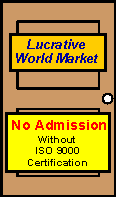The Key Manufacturing Task
How To Identify TheCritical Strategic Tasks
The Key Manufacturing Task is the focus in Focused Factories. They should have only one or two such Key Manufacturing Tasks according to Wickham Skinner.
The Key Manufacturing Task is the task that is most important for competition in the market. Skinner does not say much about determining this Key Manufacturing Task but Professor Terry Hill of Oxford University provides some guidance.
Identifying the Key Manufacturing Task starts with what Hill terms "Order Winning Criteria" or "Market Criteria." Market Criteria are the factors that customers use to decide among competing sellers. Professor Hill tells us that we should, in effect, ask the customers why they bought a particular product from a particular manufacturer. Their responses lead to the task that must be accomplished to win new orders. While essentially correct, there is more to this business of Key Manufacturing Task.


Deciders & Qualifiers
Qualifiers are criteria for which a minimum standard must be met for admission to the marketplace. In retail, for example, every product must have a UPC code. Some customers may require a QS 9000 certification or other certification for design or testing of the product. Once the "qualifying" standard or criteria has been met, all competitors are essentially equal on this dimension and it no longer discriminates between them.
Strategists may sometimes take qualifiers for granted. However, they can become sensitive "Order Losers". The loss of a certification, for example, can be disastrous in some markets.
"Deciders" are market criteria for which better incremental performance brings more orders. Price is often (but not always) a "Decider". If all other factors are equal, the competitor with the lowest price usually gets the order. Delivery is often a decider. The competitor with the fastest or most reliable delivery wins more orders.
Many such deciding factors enter into the buying decision but customers do not weight them equally. For some customers, product features dominate the decision. With other customers, delivery speed may have the most importance.
The strategist's objective is to find the dominant factors for each market segment. These are the Key Manufacturing Task(s). They then design the manufacturing system to perform well on those dimensions few dimwnsions.
Non-Manufacturing Criteria
Some market criteria are outside the purview of manufacturing. Corporate image is an example. Image is a complex and intangible phenomenon. While historical performance may affect a firm's image, market share and advertising often dominate the creation of a positive corporate image. Market share and advertising are outside the manufacturing arena. Customer support during and after the sale is another decider that is external to manufacturing.
We must identify non-manufacturing criteria and remove them from further consideration. They are important for marketing and corporate strategies but have little relevance for Manufacturing Strategy and our Key Manufacturing Task.
"The Customer Wants It All"
This refrain is frequently heard in initial discussions of the Key Manufacturing Task and Manufacturing Strategy. Rarely is it correct.
The usual situation is that several market segments exist. Lumped together, there is always some customer, somewhere that wants a particular criteria. Some want delivery more than anything; others only consider price; still others want quality. Here is where we must work closely with marketing to identify the segments and consider them separately.
All this may seem simple-minded and self-evident but it is surprising that many organizations do not examine these issues.
Case Studies
This case study illustrates how a manufacturer can move from a "We have to do everything for everybody" mentality to a more focused emphasis on Delivery and Quality. Key Manufacturing Task for Substation Transformers
■ ■ ■ ■ ■ ■ ■



